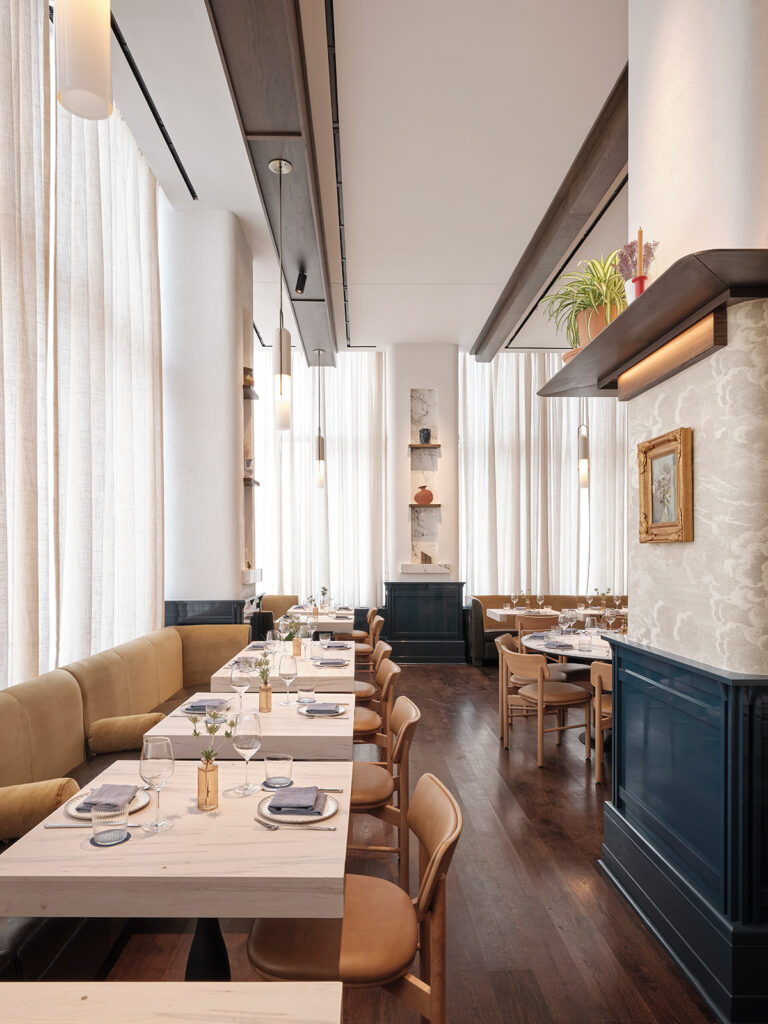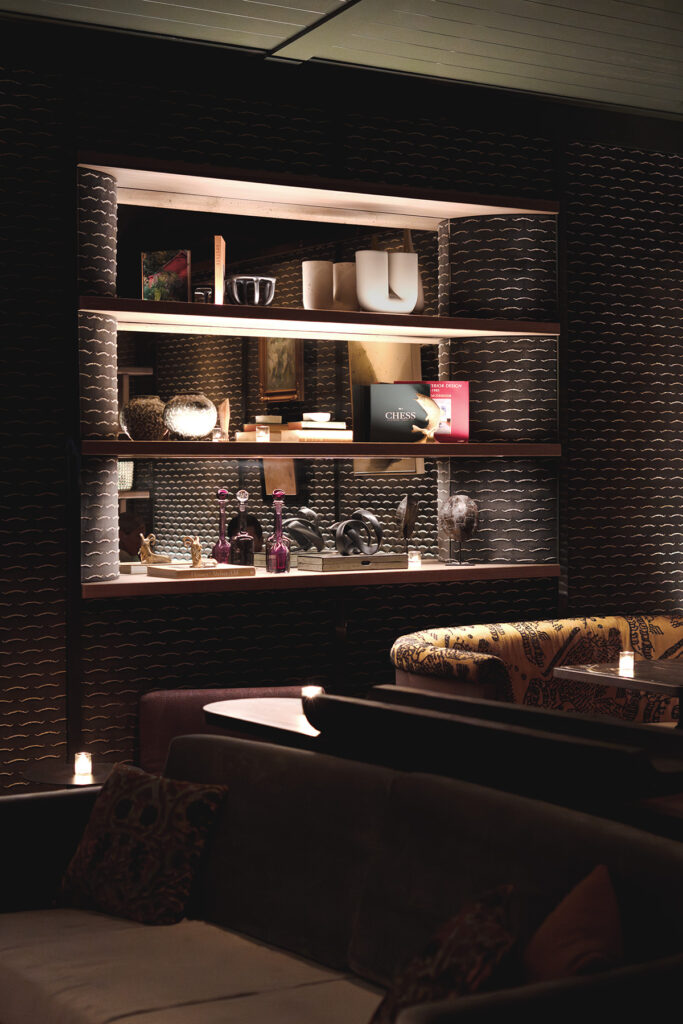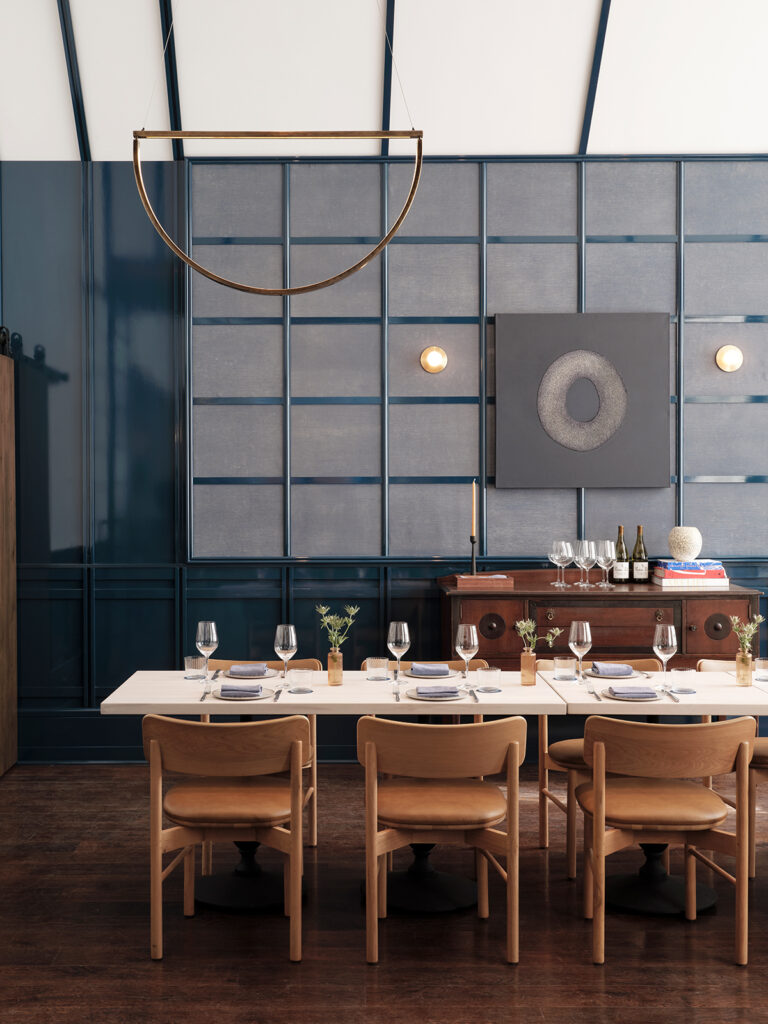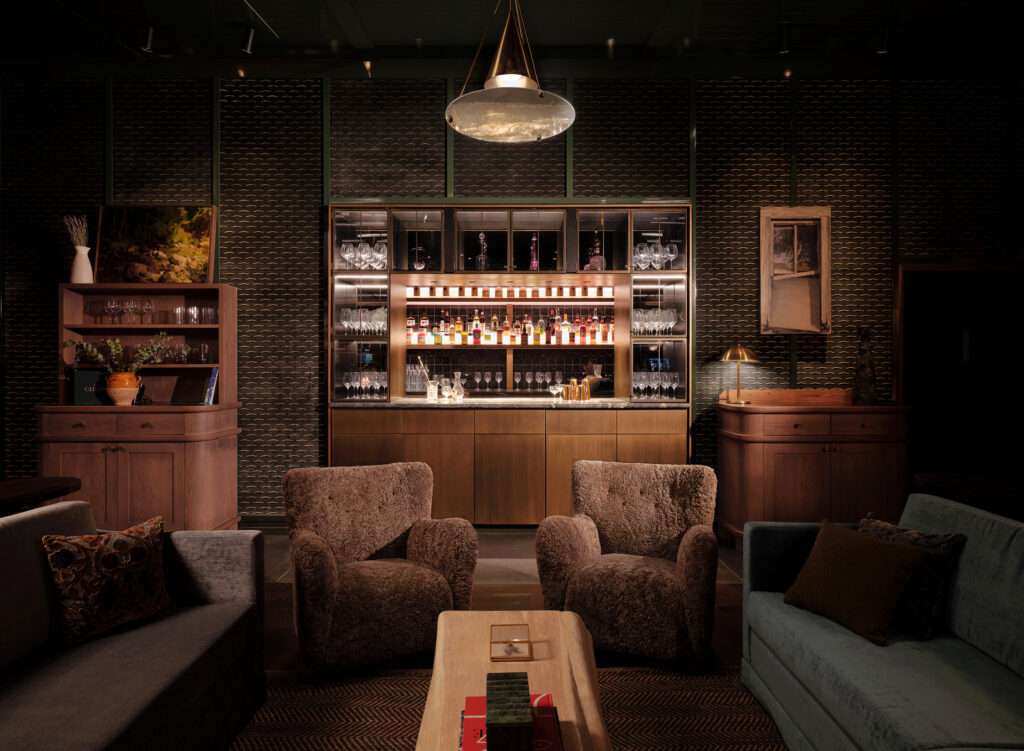Header: Parts and Labor Design. Greywind. Credit: Jonathan Pilkington
In the heart of Hudson Yards, acclaimed chef Dan Kluger introduced Greywind, his latest culinary venture that promises a dining experience as unique as its menu. As the visionary behind Loring Place and formerly of ABC Kitchen, Kluger has teamed up with Parts and Labor Design to bring his vision to life. This dynamic design studio, founded in 2009, has left an indelible mark on hospitality, commercial, retail, and residential spaces, and their collaboration with Kluger has birthed a distinctive duality within Greywind and its accompanying cocktail bar, Spygold.
Greywind, inspired by the charm of modern Hudson Valley farmhouses and bathed in natural light streaming through floor-to-ceiling windows, boasts an open and airy ambiance. Elements of natural wood, bronze fixtures, and carefully selected linens create a warm and inviting atmosphere. Adorned with an array of artwork curated by the local contemporary art gallery Sugarlift, Greywind becomes a canvas for both culinary and visual delight.


Contrasting this luminosity is Spygold, the subterranean cocktail bar designed with an intentional juxtaposition. Conceived as a cozy retreat, Spygold is a study in contrasts with its dark and intimate setting. Plush seating, layered textiles, and moody lighting envelope patrons in an atmosphere that feels more like an exclusive hideaway than a traditional bar. The walls, wrapped in patterned Italian velvet, showcase a carefully curated selection of artwork from Sugarlift, while a floor-to-ceiling leathered marble fireplace imparts a homey allure, making guests feel as though they are sipping drinks in the comfort of someone’s living room.


Behind this captivating design narrative is Parts and Labor Design, a studio defined by its creative ethos and forward-thinking approach. Led by dynamic designers Jeremy Levitt and Danu Kennedy, the studio thrives on a diversity of experiences and perspectives, fostering a unique culture that permeates every project. Their process begins with an immersive exploration into the brand and vision of their clients, shaping a conceptual narrative that guides the design journey. By focusing on integrated programming, functionality, and the infusion of highly customized furniture and lighting, Parts and Labor Design ensures each space possesses a distinct personality, aligning seamlessly with the ethos of their clients.
As we delve into the world of Greywind and Spygold, this interview with Parts and Labor Design provides an exclusive peek behind the curtain, exploring the meticulous craftsmanship and thoughtful design philosophy that elevate these spaces into immersive and unforgettable destinations.
Greywind and Spygold are two distinct spaces with contrasting aesthetics. Can you describe how you approached the design process to create a modern farmhouse-inspired restaurant and an intimate, cozy cocktail bar under one roof?
We would describe Greywind and Spygold’s aesthetics as complementary, like two sides of the same coin. Having two connected venues is always a fun challenge and it allows us to play with elements of surprise, compression, and release. In this instance, the design manifested as a sort of day-to-night journey.
Both spaces offer the same considered level of design and experience, but they achieve that through different scales, pallets, and food and beverage offerings.
Between Greywind, the bakery, the chef’s table, the private dining room, and Spygold guests have a multitude of experiences to indulge in. This approach allows for a memorable and layered visit allowing guests to choose their own adventure. Creating warmth, intimacy, and interest throughout each of these elements ties the venue together as a considered offering.

Greywind features elements of natural wood, bronze fixtures, and curated artwork. How did you blend these components to achieve a bright and airy atmosphere while paying homage to the Hudson Valley’s design influences?
The Hudson Valley’s natural beauty, rich history, and unique artisanal heritage informed the selection of furnishings, lighting, artwork, and accessories throughout. An eclectic mix of styles and materials speaks to the residential setting and invokes an eclectic homeowner’s personal collection of curiosities found while traveling, antiquing, or inherited from friends and family.
With this approach in mind, we chose to use colors, materials, and details that feel inviting, pleasant, and earthy. We referenced historic approaches, applications, and architectural forms to tap into a language that is authentic to both the Hudson Valley region and to New York City.
Spygold, on the other hand, is described as dark and cozy with plush seating and moody lighting. Can you share the design choices that were made to create an intimate and inviting space?
Conceptually, Spygold was thought of as the drawing room, den or library. It served as an opportunity to create something unexpected and surprising within the venue. Upon entering through a heavy velvet curtain, guests are greeted by the warm firelight of the floor-to-ceiling fireplace, framed in leathered marble.
Opposite the fireplace and recessed into the wall is an intimate, jewel box of a bar clad in burnished brass. The walls are covered in a deep green and cream-patterned Milanese velvet from Dedar. A similar patterned fabric makes its way into the banquettes.
The pitched and slatted ceiling, lacquered in a glossy ripe olive hue creates a sleek reflection in contrast to the knotty, dark-stained oak flooring below. An eclectic mix of lounge furniture dots the space, inviting guests to make it their own. Light levels are kept intentionally low and candles flicker throughout. These elements work together to create an intimate and seductive retreat from the city streets above.

Your studio’s portfolio includes a diverse range of projects, from hospitality to residential spaces. How do you approach each project uniquely to ensure a distinct personality and identity for each space?
Our approach is rooted in concept. At the onset of every project, we find enormous value in spending time doing research, having conversations, sharing inspiration, and crafting text that illustrates our vision for the space.
This concept, in tandem with the architecture at large, allows us to establish a narrative that everyone involved in the project can reference. This narrative serves as our guidepost throughout the design, from the space planning and material choices to the art and furniture selections. This ensures a holistic approach that embodies integrity and originality in design and provides a tailored experience for our clients, guests, owners, and brand partners.
The integration of art and decor seems to be a significant aspect of your design philosophy. Can you elaborate on how art and design work together in your projects, such as those at Greywind and Spygold?
Art and decor are integral in all of our projects. For some projects, it is the crucial finishing touch, in others we actively seek opportunities to highlight unique art works within the context of our design.
We really enjoy collaborating with and celebrating other makers and artists across disciplines and mediums. In Greywind and Spygold specifically, we knew art and decor would be a major focus. We worked with Sugarlift, a local art gallery here in NYC to curate each venue with original artwork that spoke to and enhanced our core concept narrative. These artists included Bennett Bossert, Janna Watson, Tommy Kwak, Roberto Rosenman, Laura Manuel, and Kostas Papakostas.
As a full-service design firm, you offer custom furniture and lighting design services. Could you share a specific example of a custom piece created for Greywind or Spygold that adds a unique touch to the space?
Custom furniture and lighting design are an important and integral component of our process. We pride ourselves on this considered approach to the built environment. The furniture and lighting are not separated from the space they inhabit, instead, we find that they are a crucial component of the project at large and offer a human scale, intimate level of engagement, and tactility within the larger guest experience.
In Greywind, one of our favorite custom pieces is the dining tables. They are constructed out of a bleached ambrosia maple which has a beautiful and unique look. Ambrosia maple is maple wood that has had beetles bore into its trunk and they leave these colored streaks as they travel. When you bleach the wood it creates an almost stone-like veining look. It’s a really special finish and we were happy to work with fabrication partners who helped us achieve this effect.
We also love the ceramic and glass light fixtures we produced for the bar and dining room. We developed custom glazes to highlight the unique ceramic forms we designed. Each of these lights is made by hand, and the beautiful diffused light highlights the irregularities and imperfections that make each piece one of a kind.










